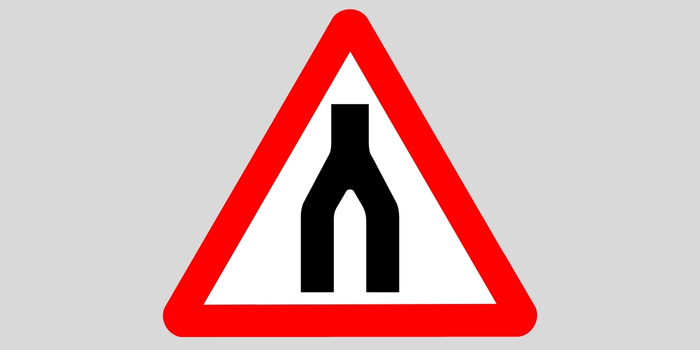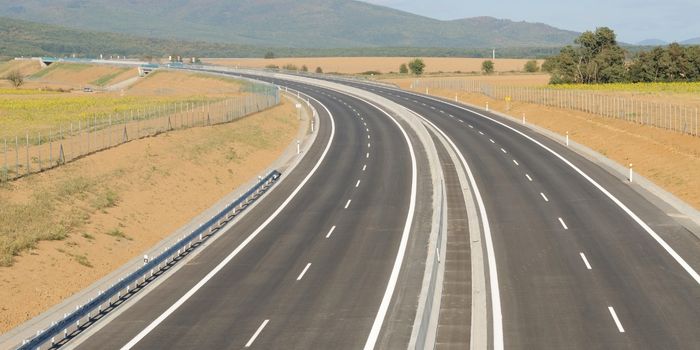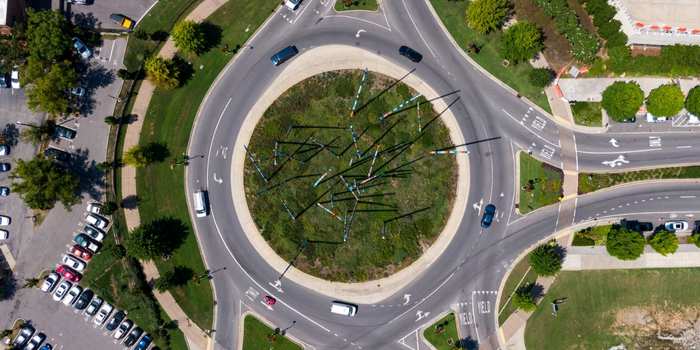You will notice end of dual carriageway signs on highways and roads. Do you really know what these signs mean and why they are placed? It may look simple but has a major role to reduce accident ratio.
That’s why we have prepared this guide for you. We will explain the meaning of end of dual carriageway sign means, its shape, speed rules, benefits and official requirements.
Dual Carriageway Ends Sign
The end of dual carriageway road sign is installed to tell you that your path ahead will no longer have a central divider. This means that now traffic from both directions will flow on the single road.
You must drive carefully and also reduce your vehicle speed. These signs also inform you that you should watch road markings and check for other vehicles moving on the opposite side.

Where Dual Carriageway End Sign is Used?
Highway authorities placed these signs where dual carriageways switch into one carriageway. You will also see this sign before the divider ends. These signs provide you enough time to adjust your car speed as well as position.
Generally, you will find “dual carriageway end” signs on highways, rural roads and near towns where road layouts are too narrow. Furthermore, it is also installed before junctions and areas with heavy traffic flow from the opposite side.
Shape & Color of Dual Carriageway End Sign
The dual carriageway end sign has a triangle road sign shape. It points in an upward direction. You see a thick red border with a white background. Inside this sign, you will find a black symbol. This symbol shows you two separate lanes that merge into one.
Basically, this shape and colors are international standard design used to give warning. Its red border makes the sign stand out and highly visible to you. Plus, the clear and bold symbol assists you to quickly know that the central divider will finish now.
Maximum Speed Limit For End of Dual Carriageway
When you see the dual carriageway end sign, you should be prepared for a lower speed limit. Because on a single carriageway, you have to drive with low speed as compared to dual carriageway.
For undivided roads, the maximum speed limit is up to 70 mph. But some signs may set a lower limit. If your vehicle is towing a trailer, then a speed of 60 miles per hour is safe for you. The reason is, you will find no central divider plus traffic moving on opposite sides of the same road.
That’s why more time is required for reaction to oncoming wheeled transport. You will also find speed limit signs after dual carriageway ends. They will show you the exact maximum speed allowed for a single carriageway.
Road Layout After Dual Carriageway End Sign
- After the placement of the dual carriageway ends sign, the road will change into an undivided highway.
- Traffic from both directions will use the same part of the road.
- You will see no central divider or barrier to separate the lanes on the route.
- Also, the oncoming vehicles will be much closer to you.
- The lanes will be narrower and the road may have more curves and hills.
- You might also find more side roads, driveways and junctions where vehicles can enter & exit.
- You will also notice pedestrian crossings and bus stops nearby single carriageway.
- This type of road layout requires lower vehicle speed & safe distance from other vehicles and drivers should stay alert.
Hazards After Dual Carriageway Ends
Slow Traffic
After the dual carriageway ends, traffic moves more slowly than you expect. Heavy vehicles, buses & tractors also reduce the overall speed. This can cause congestion and increase the risk of crashes.
Risk of Head-On Crashes
Generally, the central divider disappears after you spot dual carriageway ends signs. As a result, cars from both directions share the single lane. This increases the risk of head on collision (mostly on narrow roads/sharp bends).
Lanes Merging
After the divided highway, all separate lanes join into a single lane. In this way, you will observe a lot of traffic jams and chances of collisions if you are not well aware about hazards.
Overtaking
If you pass over other vehicles, it will be more dangerous for you after the dual carriageway area. You can’t see other road users and hills. This makes your sudden overtake risky.
On & Off Ramps
At slip ramps, vehicles enter and leave suddenly. In this way, the risk of collisions increases if drivers are not alert. Also, traffic flow will be less predictable for you in these zones.
Sharp Bends
When single carriageway roads start, you can’t see signs and traffic properly due to tight curves. Thus, you may misjudge speed and distance that raises the risk of crash.
Pedestrians or Cyclists
You may find walking people and cyclists in this area. Their presence maximizes the chances of traffic mishaps. You should be alert and drive with more focus.
Single Carriageway vs Dual Carriageway
Following is the major difference between single carriageway and dual carriageway.
| Aspects | Single Carriageway | Dual Carriageway |
| Layout | One route with transport flow in both directions | Two separate ways and divided by central barrier |
| Lanes | Generally has one lane per direction | Mostly two or more lanes on each side |
| Speed Limit | Low speed limit | High speed limit |
| Use | Rural roads & small highways | Main highways and busy roads |
| Road Signs | Has end of dual carriageway sign | Signs warn you when carriageway starts or ends |

Dual Carriageway Roundabout
You will find a roundabout after a dual carriageway ends. Roundabouts on dual carriageways connect a divided path with multiple lanes. You will see traffic move around it from both sides. These zones can be confusing for you if you don’t know about its layout.
You may find multiple entry and exit points, which increases the chance of mishaps if drivers are not focused. Therefore, dual carriageway end signs are placed to inform you about such merging places.

Importance of End of Dual Carriageway Sign
End of dual carriageway signs installed on roads to promote road users safety. Below are some examples that show how they are beneficial for you to avoid danger.
Improves Driver Awareness
This sign supports motor operators to stay alert while driving. They inform you about road changes. It also reminds you to check other vehicles on the road. You can identify other possible hazards such as narrow lanes and steep curves.
Prevents Head-On Collisions
It warns you that the central divider on your way is ending. You can drive in your lane and maintain distance from other vehicles. So that, you can reduce speed and drive carefully. These all things reduce the overall risk of head on accident.
Helpful in Poor Visibility Areas
These signs are very useful for you when visibility is low such as in fog, rain and at night. You can easily notice them from far away and get ready for road changes. In this way, it prevents traffic hazards when you face difficult driving conditions.
Speed Adjustment
The sign guides you to slow down your car because the dual carriageway will end soon. You can adjust your speed safely and on time. Also, this makes it possible for you to handle narrow lanes. In this way, you can maintain vehicular flow and avoid sudden moves.
Reduces Confusion
You don’t need to make guesses about oncoming road conditions and traffic flow. These signs provide you clear information when lane merge and divider end. You can drive safely according to traffic rules shown on sign boards.
Law Enforcement
These signs help police to monitor traffic without compromising safety of drivers. They can easily remind road users about required actions and rules. Additionally, road safety officers can control vehicle speed and reduce accidents.
Limits Overtaking Risk
Dual carriageway ends sign let you know that if you overtake a vehicle, it can be dangerous for you. They are mostly placed in unsafe areas to minimize chances of road incidents caused by overtakes.
End of Dual Carriageway Sign Rules
The following are some legal standards that you have to follow whenever you see the end of dual carriageway signs on your way.
- You have to slow down your motor vehicles when you observe this sign.
- Always stay in your lane and watch for oncoming autos from the opposite direction.
- You should be ready for narrow traffic lanes and possible bends on route.
- Also check for side roads for transport that join the road.
- You must follow the posted speed limits which you spot after this sign.
- It’s mandatory to avoid overtaking in unsafe areas.
- Further, you should stay alert for pedestrians and cyclists who use the same path.
- When you see a vehicle ahead of you, you must keep a safe distance from it.
Conclusion
Finally, now you have good information about the end of dual carriageway signs and their advantages. It’s important for you to follow these road hazard signs, so you can avoid crashes and stay safe while moving to the single carriageway.
Are you looking for high-quality end of dual carriageway signs in bulk? JACKWIN is your trusted supplier in China. You can share your requirements and get a quick quote for customized road safety products.


-80x69.png)

